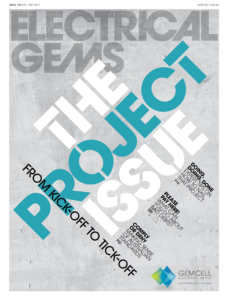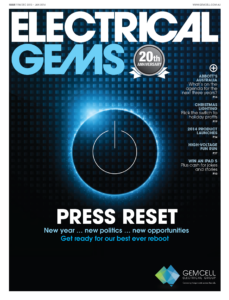Out Now
The Infrastructure Issue
Current Issue
The Infrastructure Issue
JUN - JUL 2025

Performance reviews get a bad rap, but done well they can be essential to get the best out of your people.
Performance reviews. Don’t you love them? As an employee, it’s your annual chance to get praise (or be told all about your shortcomings). As an employer, it’s your annual chance to block a few days out of your diary and identify all of the things your people are doing well… and not so well.
In truth, performance reviews aren’t overly popular. In fact, a Gallup study found only one in five employees reckoned their company’s performance review process was motivating.
It also helps encourage communication, and strengthens relationships between employees and managers too.
So, what’s the best way to approach it? What can we do to ensure we’re getting the very best out of the opportunity to speak with our people and help them get better at their roles – as well as us with ours?
We take a look at a few different approaches to performance reviews, and look at how you can possibly get the most from your review process.
How it works: The traditional annual review is a conventional approach used in organisations across the globe.
Typically, it involves a face-to-face meeting between the employee and their supervisor, and covers off the employee’s performance over the past year, goals achieved, areas for improvement, and future objectives.
On the plus side: An annual review provides a structured framework for evaluating performance and setting goals, and gives the opportunity for a comprehensive overview of the employee’s progress over a significant period.
Where it’s lacking: Infrequent feedback may lead to issues being overlooked or not addressed promptly. After all, if something crops up the month after one review, you’re not going to wait 11 months to address it. Employees may feel anxious or pressured leading up to the annual review, and performance may suffer as a result.
How it works: The 360-degree feedback review involves feedback from multiple sources, including peers, people who report to you, supervisors, and even clients. Feedback is collected anonymously and compiled into a report for the employee to review.
On the plus side: This approach provides a well-rounded view of the employee’s performance, encourages collaboration and teamwork, and fosters a culture of feedback.
Where it’s lacking: Can be time-consuming to administer and may result in conflicting feedback. Some employees may feel uncomfortable providing honest feedback about their peers, even on the condition of anonymity.
How it works: The continuous feedback review sprung up from more agile and responsive performance management practices, and involves providing feedback on an ongoing basis, rather than waiting for scheduled review periods. Feedback can be given informally through regular check-ins or more formally through structured sessions.
What to love: Allows for timely feedback that can address issues as they arise, promotes continuous improvement, and fosters open communication between employees and supervisors.
What not to love: Requires a commitment to frequent communication, which may not always be feasible in busy work environments. Employees may become overwhelmed by constant feedback if it’s not delivered constructively.
How it works: Focuses primarily on setting and evaluating progress towards specific goals and objectives. Reviews may occur quarterly or biannually to track progress. This style of review stems from the motivational theory of goal setting.
What to love: This approach provides a clear framework for assessing performance based on measurable outcomes, promotes accountability, and helps align individual goals with organisational objectives.
What not to love: May overlook qualitative aspects of performance that are not easily quantifiable, and employees may become overly focused on achieving goals at the expense of other important tasks or responsibilities.
How it works: The approach, which is based on positive psychology principles, focuses on identifying and leveraging the employee’s strengths rather than focusing on weaknesses. Reviews may involve discussions about how to capitalise on an individual’s strengths to achieve optimal performance.
What to love: This is a sure-fire way of boosting employee morale and engagement by recognising and building up their strengths (who doesn’t like to hear great stuff about themselves?!). It may also foster a more positive work environment, and encourage employees to excel in areas where they have natural talent.
What not to love: You may neglect addressing areas where improvement is needed, potentially leading to stagnation or underperformance if weaknesses are not addressed.
How it works: Consists of brief, regular check-ins between the employee and their manager or supervisor, and is often conducted weekly or biweekly. These meetings focus on discussing current projects, challenges, and progress towards goals.
What to love: Allows for real-time feedback and course corrections, builds stronger relationships between employees and supervisors, and helps identify and address issues before they escalate.
What not to love: May lack the depth of analysis provided by more formal review processes, and issues requiring more substantial discussion or resolution may be overlooked in brief check-ins.

The $64,000 question… and the answer is probably a combination of a lot of the above.
Firstly, having a formal review – once or twice a year – is invaluable. It creates a framework to have conversations about performance, the business and the industry, and provides the opportunity to set achievable goals and expectations.
How you do that will depend on your business, but it’s important to be prepared and consider everything the employee brings to the business, including those soft skills that cannot be measured.
Getting 360-degree feedback could be hugely valuable in a contracting business – after all, some people will be working alone or in teams on site. By setting up a regular mechanism to collect feedback from customers and colleagues, you can collect valuable data that can be used to assess performance and spot opportunities for improvement.
If you’ve set goals and are collecting continuous feedback, then a regular weekly or fortnightly check-in focused on both of those ensures feedback is shared promptly, and individuals can remain on course.
Keep up to date with our latest news and competitions by subscribing to our regular newsletter.

Issue 183
OCT - NOV 2024

Issue 182
AUG - SEPT 2024

Issue 181
JUN - JUL 2024

Issue 180
APR - MAY 2024

Issue 179
FEB - MARCH 2024

Issue 178
DEC 2023 - JAN 2024

Issue 177
OCT - NOV 2023

Issue 176
AUG - SEPT 2023

Issue 175
JUN - JUL 2023

Issue 174
APR - MAY 2023

Issue 173
FEB - MAR 2023

Issue 172
DEC 2022 - JAN 2023

Issue 171
OCT - NOV 2022

Issue 170
AUG - SEPT 2022

Issue 169
JUN - JUL 2022

Issue 168
APR - MAY 2022

Issue 167
FEB - MAR 2022

Issue 166
DEC 2021 - JAN 2022

Issue 165
OCT - NOV 2021

Issue 164
AUG - SEPT 2021

Issue 163
JUN - JUL 2021

Issue 162
APR - MAY 2021

Issue 161
FEB - MAR 2021

Issue 160
DEC 2020 - JAN 2021

Issue 159
OCT - NOV 2020

Issue 158
AUG - SEPT 2020

Issue 157
JUN - JUL 2022

Issue 156
APR - MAY 2020

Issue 155
FEB - MAR 2020

Issue 154
DEC 2019 - JAN 2020

Issue 153
OCT - NOV 2019

Issue 152
AUG - SEPT 2019

Issue 151
JUN - JUL 2019

Issue 150
APR - MAY 2019

Issue 149
FEB - MAR 2019

Issue 148
DEC 2018 - JAN 2019

Issue 147
OCT - NOV 2018

Issue 146
AUG - SEPT 2018

Issue 145
JUN - JUL 2018

Issue 144
APR - MAY 2018

Issue 143
FEB - MAR 2018

Issue 142
DEC 2016 - JAN 2017

Issue 141
OCT- NOV 2017

Issue 140
AUG - SEPT 2017

Issue 139
JUN - JUL 2017

Issue 138
APR - MAY 2017

Issue 137
FEB - MAR 2017

Issue 136
DEC 2016 - JAN 2017

Issue 135
OCT - NOV 2017

Issue 134
AUG - SEPT 2016

Issue 133
JUN - JUL 2016

Issue 132
APR - MAY 2016

Issue 131
FEB - MAR 2016

Issue 130
DEC 2015 - JAN 2016

Issue 129
OCT - NOV 2015

Issue 128
AUG - SEPT 2015

Issue 127
JUN - JUL 2015

Issue 125
APR - MAY 2015

Issue 125
FEB - MAR 2015

Issue 124
DEC 2014 - JAN 2015

Issue 123
OCT - NOV 2014

Issue 122
AUG - SEPT 2014

Issue 121
JUN - JUL 2014

Issue 120
APR - MAY 2014

Issue 119
FEB - MAR 2014

Issue 118
DEC 2013 - JAN 2014

Issue 117
OCT - NOV 2013

Issue 116
AUG - SEPT 2013

Comments (0)
Write a Comment